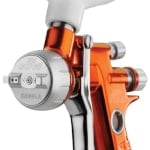|
|
|
Climatic Testing
 | The monitoring of climatic conditions such as temperature, relative humidity, dew point and moisture in industry is often vital to the success of the application of a coating. These parameters determine both the conditions for the application of the coating, and the resulting quality and performance of the coated product. In the protective coatings industry, moisture can form on the surface when the surface temperature is low enough to cause condensation from the atmosphere. The dewpoint temperature (Td) is the point at which this occurs.
Monitoring the surface tempearte (Ts) relative to the air temperature (Ta) and its relative humidity (%RH) allows the dewpoint temperature to be calculated and compared to the surface temperature. This difference in temperature (TΔ) is the key parameter dictating when it is safe to apply the coating.
The temperature of the coating material is also important as temperature affects the coating′s shelf life, viscosity and its application characteristics.
The continuous monitoring of the climatic conditions during the cure process (drying) is also required. If the temperature is too high, the coating can dry too quickly, leading to surface defects. If the temperature is too low, the cure time is extended, leading to delays in applying a further coat, other types of surface defects may affect the further coat, such as amine blush.
The cure process for powder coating requires a specific temperature to be achieved for a specific period. Monitoring the oven profile allows the user to ensure that the product is brought to the appropriate temperature and held at that temperature for the specified time. If the oven or product is too hot, the coating can burn, if it is too cold, the coating does not cure, leading to poor adhesion and appearance.
The presence of moisture within a material will result in poor adhesion, premature coating failure and poor appearance. For example, applying a powder coating to a damp wooden panel will cause steam to be created when the panel passes through the curing oven, thus causing damage to the coating. |
The monitoring of climatic conditions such as temperature, relative humidity, dew point and moisture in industry is often vital to the success of the application of the coating. These parameters determine both the conditions for application of a coating, and the resulting quality and performance of the coated product.
In the protective coatings industry, moisture can form on the surface when the surface temperature is low enough to cause condensation from the
atmosphere. The dew point temperature (Td) is the point at which this occurs.
Monitoring air temperature (Ta) and its relative humidity (%RH) allows the dew point temperature to be calculated and compared to the surface temperature (Ts). The difference in temperature (TΔ) is the key parameter dictating when it is safe to apply the coating.
|
Elcometer hygrometers have been specifically designed for use in very hot climates where the surface temperature of the substrate can exceed the paint manufacturer's recommend limits for successful painting.
Painting outside recommended limits can have a detrimental affect on the performance and lifetime of the coating. The Elcometer 308 Hygrometer provides a simple and fast measurement of relative humidity and surface temperature.
|
During the application of a coating, the presence of moisture in the environment, or on the work surface, often results in a poor quality finish. Problems such as poor adhesion of the coating, delayed drying time or premature corrosion of the substrate can occur.
Before proceeding, it is essential that the air temperature and relative humidity (RH) are measured to calculate the dew point. The difference between this and the surface temperature
is displayed as ∆T, with a warning if necessary.
|
Gauges to evaluate moisture content on a variety of substrates. Pin-type moisture meters: Invasive pins are pushed firmly into the surface of the substrate being measured and by measuring the electrical resistance between the pin electrodes provide the percentage moisture content (%MC) in the substrate. Pinless, contact-type moisture meters: Whilst pinless meters typically measure moisture content faster and are non-destructive they do require a relatively flat surface because the sensors are mounted on the base of the gauge making them ideal for concrete.
|
The Elcometer 215 is an easy to use oven temperature data recorder, ideal for measuring the temperature profiles of both the sample and the oven during the curing process. Logging both the product′s surface temperature and the air temperature in the oven, the Elcometer 215 identifies the achieved "Temperature Profile" and provides the user with information to ensure consistent quality.
|
During the application of a coating, the presence of moisture in the environment, or on the work surface, often results in a poor quality finish.
Problems such as poor adhesion of the coating or premature corrosion of the substrate can occur.
To determine the likelihood of moisture affecting the quality of the finish, it is essential that the surface temperature, air temperature, relative humidity (RH) and dew point are all measured.
|
During the application of a coating, the presence of moisture in the environment, or on the work surface, often results in a poor quality finish.
Problems such as poor adhesion of the coating or premature corrosion of the substrate can occur.
To determine the likelihood of moisture affecting the quality of the finish, it is essential that the surface temperature, air temperature, relative humidity (RH) and dew point are all measured.
|
The lightweight impeller with high precision jewel bearings provides very accurate airflow measurements even at low speeds. The anemometer's impeller can easily be replaced without the need to return the unit to Elcometer.
The wind speed can be displayed in various measurement units; indicating current speed, maximum speed or average speed.
|
|
|
|
|
|






















